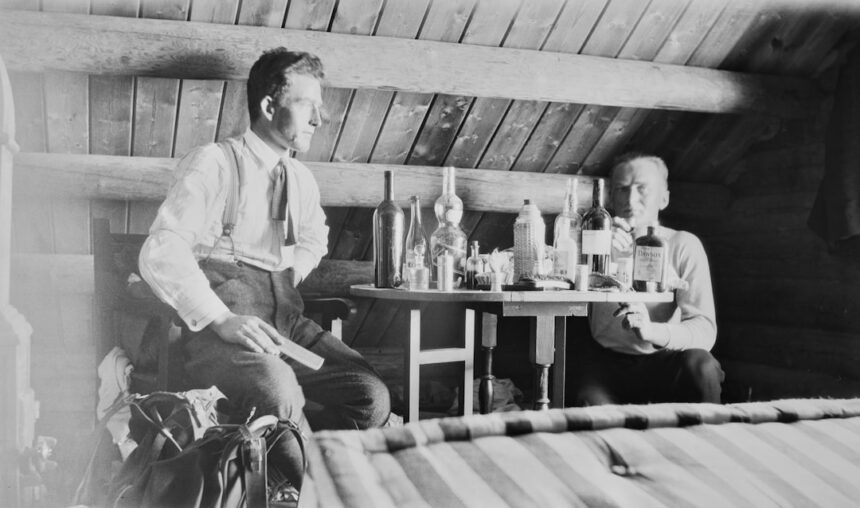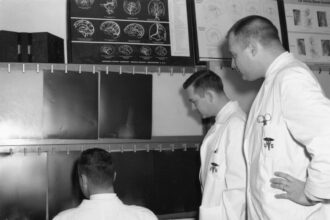The post-World War II era marked a significant turning point in the history of space exploration, particularly with the establishment of NASA in 1958. Among the many contributors to this ambitious endeavor were scientists who had previously worked under the Nazi regime in Germany. This controversial recruitment of former Nazi scientists, often referred to as Operation Paperclip, has sparked extensive debate regarding the ethical implications of their involvement in American scientific advancements.
The complexities surrounding this historical narrative reveal not only the desperation of the United States to secure technological superiority during the Cold War but also the moral dilemmas that arise when progress is intertwined with a dark past. The involvement of these scientists in NASA’s early projects highlights a paradox: while they contributed significantly to advancements in rocket technology and space exploration, their previous affiliations with a regime responsible for heinous crimes against humanity cast a long shadow over their achievements. This article delves into the recruitment process, the contributions of key figures like Wernher von Braun, and the broader implications of employing individuals with such controversial backgrounds.
By examining these facets, one can better understand the intricate relationship between scientific progress and ethical considerations in a world shaped by war and conflict.
Key Takeaways
- Nazi scientists played a significant role in the development of NASA, contributing to the space agency’s early successes.
- The United States recruited Nazi scientists after World War II, including Wernher von Braun, to gain their expertise in rocket technology.
- Wernher von Braun, a former Nazi scientist, made substantial contributions to NASA’s early space missions, including the development of the Saturn V rocket.
- Nazi scientists’ work on rocket technology during World War II laid the foundation for NASA’s advancements in space exploration.
- The use of Nazi scientists in NASA has sparked controversy and raised ethical and moral questions about their involvement in the space agency’s history.
The Recruitment of Nazi Scientists by the United States
In the aftermath of World War II, the United States found itself in a race against time to harness advanced technologies that could bolster its military and scientific capabilities. The Soviet Union’s rapid advancements in rocket technology heightened this urgency, prompting American officials to seek out expertise wherever it could be found. The recruitment of German scientists, engineers, and technicians became a strategic priority, leading to the establishment of Operation Paperclip.
This covert program aimed to bring prominent figures from Nazi Germany to America, often overlooking their past affiliations in favor of their technical skills. The recruitment process was fraught with moral ambiguity. Many of these scientists had played pivotal roles in developing weapons for the Nazi regime, including the V-2 rocket, which was used against Allied cities during the war.
S. officials justified their actions by emphasizing the potential benefits these individuals could bring to national security and technological advancement. The decision to overlook their pasts was driven by a sense of urgency; the Cold War was looming, and America needed every advantage it could muster to compete with its ideological rival.
Wernher von Braun and His Contribution to NASA

One of the most notable figures among the recruited scientists was Wernher von Braun, a visionary engineer whose work would become synonymous with America’s space program. Von Braun’s expertise in rocketry was unparalleled, and his contributions laid the groundwork for many of NASA’s early missions. Initially involved in developing the V-2 rocket for Nazi Germany, von Braun’s transition to American soil marked a significant shift in his career trajectory.
He quickly became a leading figure at NASA, where he played a crucial role in the development of the Saturn V rocket, which ultimately propelled astronauts to the Moon. Von Braun’s influence extended beyond mere technical contributions; he was also an effective advocate for space exploration. His ability to communicate complex scientific concepts to the public helped garner support for NASA’s ambitious goals.
Through his work on various projects, including the Apollo program, von Braun not only advanced rocket technology but also inspired a generation to dream about space travel. His legacy is a testament to how one individual’s expertise can shape an entire field, even when that individual’s past is steeped in controversy.
The Development of Rocket Technology by Nazi Scientists
| Year | Event | Significance |
|---|---|---|
| 1927 | Formation of the German Society for Space Travel (Verein für Raumschiffahrt) | First organized group dedicated to rocket development in Germany |
| 1932 | Development of the A-2 rocket | First successful liquid-fueled rocket in Germany |
| 1937 | Wernher von Braun joins the German Army | Key figure in the development of V-2 rocket technology |
| 1944 | First successful launch of V-2 rocket | First man-made object to reach outer space |
| 1945 | End of World War II | Many German scientists, including von Braun, brought to the United States as part of Operation Paperclip |
The technological advancements achieved by Nazi scientists during World War II laid a foundation that would later be instrumental in America’s space endeavors. The V-2 rocket, developed under von Braun’s leadership, represented a significant leap forward in propulsion technology. Its design and engineering principles informed subsequent American rocket programs, allowing NASA to build upon existing knowledge rather than starting from scratch.
This transfer of technology was not merely a matter of borrowing ideas; it involved adapting and refining complex systems that had been developed under wartime conditions. Moreover, the expertise brought by these scientists encompassed various aspects of rocketry, including guidance systems, propulsion methods, and materials science. Their collective knowledge contributed to innovations that would eventually lead to successful satellite launches and human spaceflight missions.
The collaboration between former Nazi scientists and American engineers exemplified how wartime advancements could be repurposed for peaceful exploration, albeit with an underlying tension regarding the origins of that knowledge.
Controversy Surrounding the Use of Nazi Scientists in NASA
The decision to employ former Nazi scientists has been met with significant controversy and criticism over the years. Many have argued that it was morally indefensible to recruit individuals who had been complicit in a regime responsible for atrocities during the Holocaust and other war crimes. Critics contend that by prioritizing technological advancement over ethical considerations, the United States compromised its own values and principles.
This debate raises important questions about accountability and justice for those who participated in or benefited from oppressive systems. Furthermore, the secrecy surrounding Operation Paperclip fueled public distrust. Many Americans were unaware of the extent to which former Nazis were integrated into key positions within NASA and other government agencies.
As details emerged about their pasts, public opinion became increasingly divided. Some viewed these scientists as necessary evils in the pursuit of national security, while others saw them as symbols of moral failure. This ongoing discourse reflects broader societal struggles with reconciling progress with ethical integrity.
Nazi Scientists’ Influence on Space Exploration

The influence of Nazi scientists on space exploration extends beyond their immediate contributions to rocket technology; it also encompasses their impact on scientific culture and institutional practices within NASTheir expertise helped establish rigorous engineering standards and methodologies that became hallmarks of American aerospace engineering. The integration of these practices not only advanced specific projects but also fostered a culture of innovation that encouraged collaboration across disciplines. Moreover, the presence of these scientists facilitated international cooperation in space exploration efforts.
As they shared their knowledge with American counterparts, they also engaged with scientists from other nations, contributing to a global dialogue about space research and exploration. This exchange of ideas ultimately enriched the scientific community and laid the groundwork for future collaborative missions, such as those conducted through international partnerships like the International Space Station.
Ethical and Moral Questions Raised by the Involvement of Nazi Scientists in NASA
The involvement of Nazi scientists in NASA raises profound ethical and moral questions that continue to resonate today. At its core lies the dilemma of whether technological progress can justify overlooking an individual’s past actions, particularly when those actions are tied to crimes against humanity. This question challenges society to consider how it evaluates contributions made by individuals with controversial histories and whether it is possible to separate their professional achievements from their moral failings.
Additionally, this situation prompts reflection on broader themes of accountability and redemption. Can individuals who have participated in oppressive regimes ever truly atone for their pasts? The case of Nazi scientists at NASA illustrates how complex these issues can be, as society grapples with reconciling historical injustices with contemporary advancements.
Ultimately, these ethical considerations compel ongoing dialogue about responsibility in science and technology.
The Legacy of Nazi Scientists in NASA
The legacy of Nazi scientists within NASA is multifaceted and complex. On one hand, their contributions undeniably propelled America into a new era of space exploration, leading to monumental achievements such as landing humans on the Moon and launching interplanetary missions. Their technical expertise laid essential groundwork for future innovations that continue to shape aerospace engineering today.
On the other hand, this legacy is marred by the moral implications of their recruitment and integration into American institutions. The historical narrative surrounding these individuals serves as a reminder of how scientific progress can be intertwined with troubling ethical considerations. As society reflects on this legacy, it must grapple with both the advancements made possible by these scientists and the darker aspects of their pasts.
The Impact of Nazi Scientists on the Space Race
The impact of Nazi scientists on the Space Race cannot be overstated; their expertise played a pivotal role in shaping America’s response to Soviet advancements in space technology. As tensions escalated during this period, U.S. officials recognized that securing technological superiority was essential for national security and global standing.
The knowledge brought by former Nazi scientists allowed America to rapidly develop its own rocket programs, ultimately leading to significant milestones such as satellite launches and crewed missions. Moreover, this influence extended beyond mere technical achievements; it also shaped public perception and support for space exploration initiatives. The successful launch of satellites like Explorer 1 and crewed missions like Mercury and Apollo captured national attention and fostered a sense of pride among Americans.
The contributions made by these scientists were integral not only to technological advancements but also to cultivating public interest in space exploration during a time when competition with the Soviet Union was at its peak.
The Role of Nazi Scientists in Advancing NASA’s Missions and Goals
Nazi scientists played an instrumental role in advancing NASA’s missions and goals throughout its formative years. Their expertise contributed directly to key projects such as the Apollo program, which aimed to land humans on the Moon and return them safely to Earth. The technical knowledge they brought regarding propulsion systems, guidance technologies, and materials science proved invaluable as NASA sought to achieve unprecedented milestones in human spaceflight.
Furthermore, these scientists helped establish rigorous engineering practices that became foundational for future missions. Their influence extended beyond individual projects; they contributed to shaping NASA’s organizational culture by promoting collaboration between engineers, scientists, and policymakers. This collaborative spirit fostered an environment conducive to innovation and experimentation—qualities essential for tackling the challenges inherent in space exploration.
Reflections on the Complicated History of Nazi Scientists’ Contribution to NASA
The history of Nazi scientists’ involvement in NASA is a complex tapestry woven from threads of innovation, ethical dilemmas, and historical reckoning. While their contributions undeniably advanced America’s capabilities in space exploration, they also raise critical questions about morality and accountability within scientific endeavors. As society continues to grapple with these issues, it is essential to acknowledge both the achievements made possible by these individuals and the darker aspects of their pasts.
Ultimately, this narrative serves as a reminder that progress often comes at a cost—a cost that must be examined through an ethical lens. The legacy left by these scientists challenges contemporary society to reflect on how it values contributions made by individuals with controversial histories while striving for a future defined by integrity and responsibility in science and technology. As humanity continues its journey into space, it must carry forward these lessons learned from history—lessons that emphasize not only what can be achieved but also how those achievements are intertwined with our shared moral obligations.
The history of NASA’s formation is intricately linked with the involvement of former Nazi scientists, a topic that has been explored in various articles and discussions. One such article that delves into this complex history can be found on the website “In The War Room.” This article provides an in-depth analysis of how Operation Paperclip facilitated the transfer of German scientists, including Wernher von Braun, to the United States, where they played pivotal roles in the development of the American space program. For more detailed insights, you can read the full article by visiting In The War Room.
WATCH THIS! 🪖How Stolen Nazis Built Cold War Power
FAQs
What is the connection between Nazi scientists and NASA?
During and after World War II, the United States recruited German scientists, including former Nazi scientists, through Operation Paperclip to work on various projects, including the development of rockets and missile technology. Many of these scientists played a significant role in the establishment of NASA.
Which Nazi scientists were involved in the development of NASA?
Notable Nazi scientists who were involved in the development of NASA include Wernher von Braun, who was instrumental in the development of the V-2 rocket for Nazi Germany and later became a key figure in the American space program.
What role did these Nazi scientists play in the establishment of NASA?
Nazi scientists, particularly Wernher von Braun and his team, were crucial in the development of the American space program. They contributed to the design and development of the Saturn V rocket, which was used in the Apollo moon missions.
Did the involvement of Nazi scientists in NASA raise ethical concerns?
Yes, the recruitment of Nazi scientists by the United States government raised ethical concerns, particularly regarding their involvement in war crimes during World War II. However, the Cold War and the desire to gain a technological advantage over the Soviet Union led to the decision to bring these scientists to the United States.
What is the legacy of Nazi scientists in NASA?
The legacy of Nazi scientists in NASA is complex. While their contributions were significant in advancing American space exploration, their involvement also raises ethical and moral questions about the use of former Nazi scientists in the American space program.




